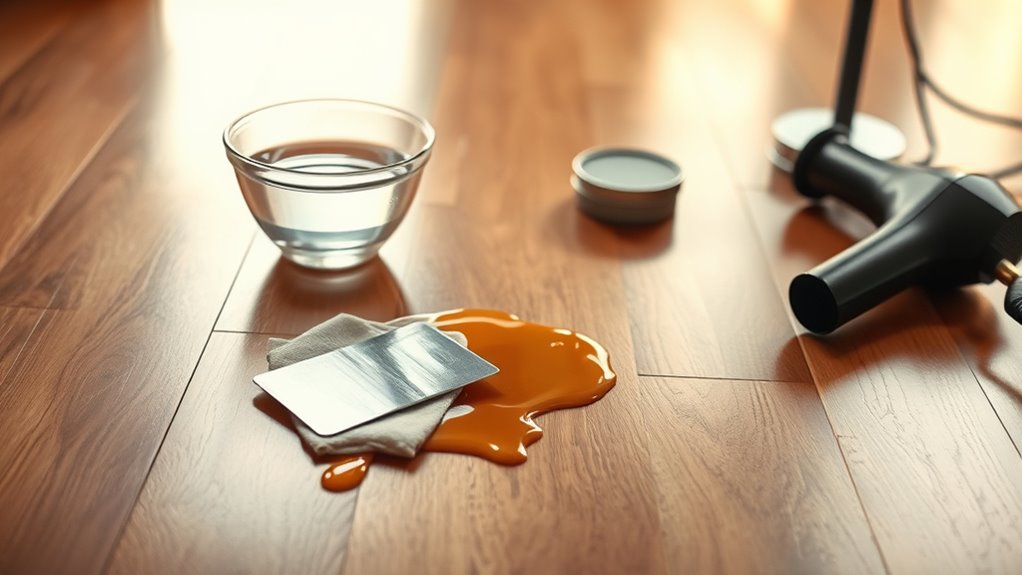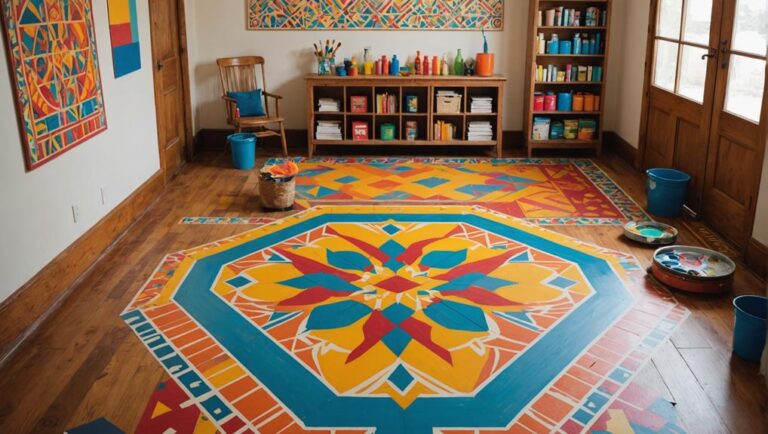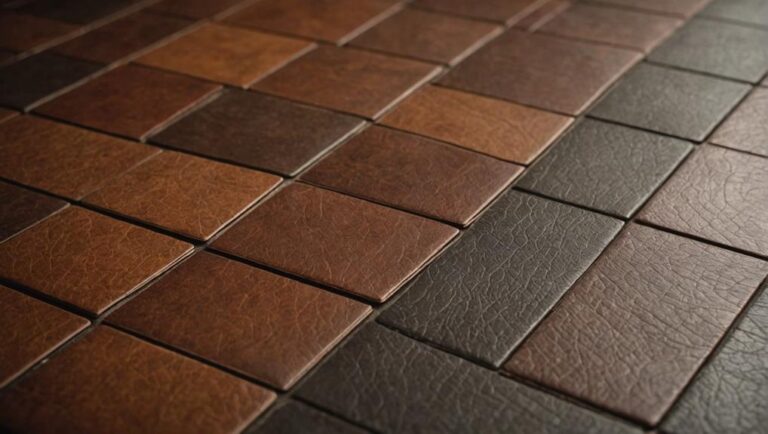First, identify your floor type to pick the right method. Let the wax harden; speeding this with ice helps. Gently scrape off excess wax using a plastic scraper or credit card at a low angle to avoid scratches. Apply mild heat with a hairdryer or iron set on low, using a cloth as a barrier, to soften remaining wax. Clean residue with a suitable solution like warm soapy water or rubbing alcohol. For detailed tips, keep exploring the best steps for your floor.
Assess the Type of Flooring
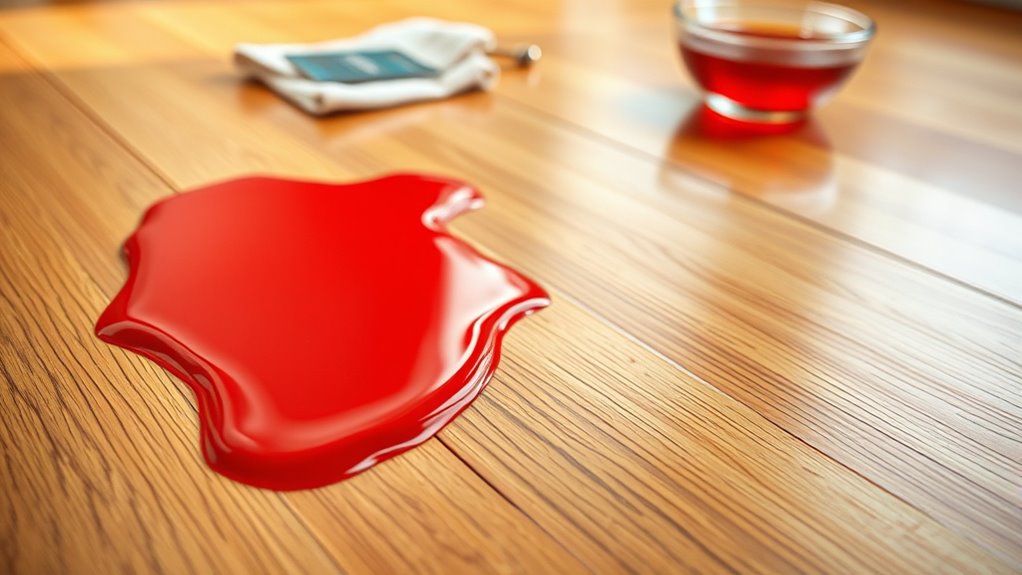
Before you begin removing candle wax, you’ll need to identify the type of flooring you have. Different surfaces demand specific care to avoid damage. For tile flooring, you can typically apply gentle heat and scrape without worry, as tiles are durable and resistant to stains. However, if your floor is carpeted, knowing your carpet types is essential. Natural fibers like wool react differently to heat and chemicals than synthetic ones like nylon or polyester. This affects the removal method you’ll choose. Evaluating your floor guarantees you select a technique that effectively removes wax while preserving your floor’s integrity. Taking this step grants you the freedom to act confidently and prevents costly mistakes during the cleaning process.
Let the Wax Harden
One essential step in removing candle wax from your floor is to let the wax harden completely. When the wax is hardened wax, it becomes solid and easier to handle without smearing or spreading. To speed up this process, you can place a plastic bag filled with ice cubes directly on the wax spot, ensuring you use floor protection like a cloth beneath the bag to prevent moisture damage. Avoid trying to clean or scrape the wax while it’s still soft, as this will only embed it deeper into your floor’s surface. By allowing the wax to harden naturally or with cold application, you prepare the area for safe and effective removal. This step protects your flooring and makes the cleanup process much more manageable.
Scrape Off Excess Wax
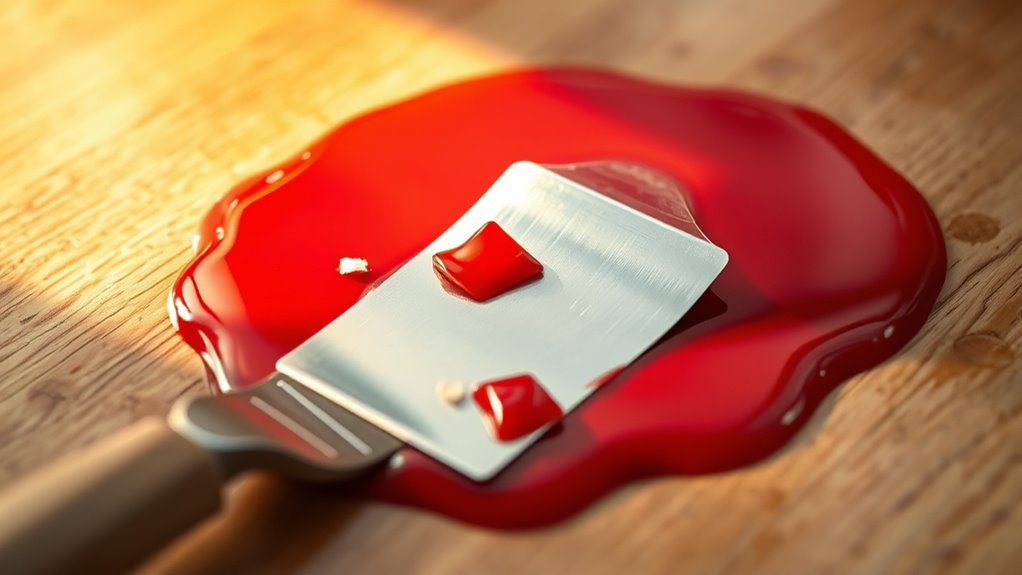
You’ll need a plastic scraper or a credit card to gently lift the hardened wax without damaging your floor. Make sure to wear gloves to protect your hands during this process. Work slowly and carefully to avoid scratching the surface.
Tools for Scraping
Gathering the right tools is essential to effectively scrape off excess candle wax without damaging your floor. Start with scraper types designed for delicate surfaces, such as plastic or silicone scrapers, which reduce the risk of scratches. Metal scrapers work well for tougher residues but use them cautiously. Choose a scraper with a comfortable handle to maintain control during the process. When applying scraping techniques, hold the scraper at a low angle and gently push the wax off, avoiding harsh pressure. Work slowly to lift the wax layers while preserving your floor’s finish. Having a variety of scrapers on hand lets you adapt to different wax thicknesses and floor materials, giving you the freedom to clean efficiently and safely.
Safety Precautions
Before you begin scraping off the excess wax, it’s important to take safety precautions to protect yourself and your floor. Proper wax removal techniques guarantee you avoid damage and injury during the process. Here are key steps to keep in mind for effective floor protection:
- Use gloves to protect your hands from sharp tools and hot wax.
- Test your scraping tool on a small, hidden area to prevent floor scratches.
- Work slowly and gently to avoid gouging or damaging the flooring surface.
- Keep the area well-ventilated if using heat-based wax removal methods.
- Clear the floor of any obstacles to maintain steady footing and avoid slips.
Following these precautions allows you confidently remove wax without compromising your safety or your floor’s integrity.
Apply Heat to Soften Remaining Wax
One effective way to remove stubborn wax residue is by applying gentle heat to soften it. Understanding wax properties helps you choose the right heat sources—like a hairdryer or warm iron. These tools gradually raise the wax temperature, making it pliable without damaging your floor. Hold the hairdryer a few inches away, moving it steadily over the wax until you see it soften. If using an iron, place a thin cloth over the wax first to prevent direct contact, then apply low heat briefly. Avoid excessive heat, which can melt wax deeper into porous surfaces or harm the floor finish. By carefully applying heat, you’ll loosen the wax, making it easier to lift away in the next step, freeing your floor from sticky residue efficiently and safely.
Clean the Residue With a Suitable Solution
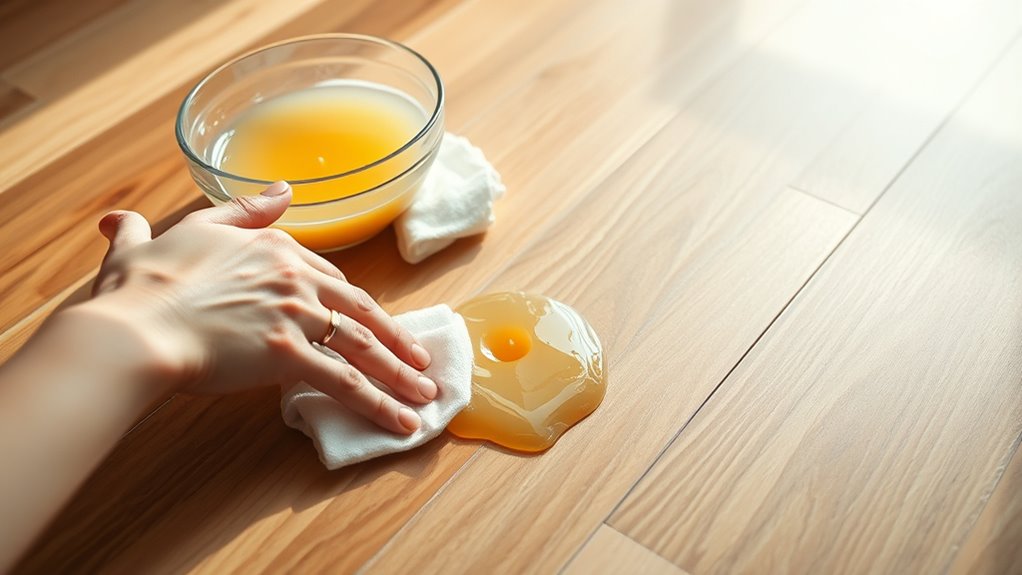
Once the wax has softened and been lifted as much as possible, you’ll need to tackle the remaining residue with the right cleaning solution. Choosing an effective cleaning solution is key to thorough residue removal without damaging your floor. Here’s how to proceed:
After softening the wax, use the right cleaner to remove residue without harming your floor.
- Test your chosen cleaning solution on a small, hidden area first.
- Use mild solutions like warm soapy water or vinegar for delicate floors.
- For stronger residue, consider rubbing alcohol or a commercial wax remover.
- Apply the solution with a soft cloth, gently rubbing in circular motions.
- Wipe the area with a clean, damp cloth to remove any leftover cleaner.
This method guarantees you remove wax residue efficiently while preserving your floor’s integrity and maintaining your freedom to enjoy a spotless space.
Polish and Restore the Floor’s Finish
After removing the wax residue, you’ll want to focus on polishing and restoring your floor’s finish to bring back its original shine. Start by selecting a floor polish compatible with your flooring type—wood, tile, or laminate—to guarantee effective floor maintenance. Apply the polish sparingly with a soft cloth or mop, working in small sections to avoid streaks. Let it dry completely, then buff the area with a clean, dry microfiber cloth or a floor buffer if you have one. This step smooths out any dullness caused by wax removal and helps protect your floor from future damage. Regularly maintaining your floor this way not only preserves its appearance but also extends its lifespan. Taking these steps gives you freedom from worry about wax spills and keeps your floor looking pristine.

